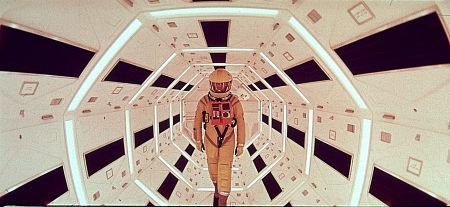|
|
Viking Night: 2001: A Space OdysseyBy Bruce HallJune 1, 2016
It’s here that we meet Heywood Floyd (William Sylvester), a government official on his way to the American moon base. NASA has discovered an alien artifact on the moon, similar to the one that (unbeknownst to them) first taught their ancestors the joy of murder. The artifact resists all attempts to study it before pointing a radio burst at Jupiter - because to these aliens, space travel is obviously a treasure hunt. Eighteen months later, a hyper advanced survey ship is dispatched to the planet, stuffed with people, equipment and one super intelligent computer named HAL-9000. HAL is a sentient, self-aware computer with a pleasant, helpful disposition and he’s responsible for running the ship on the long journey. While the science team is in suspended animation, astronauts Dave Bowman (Kier Dullea) and Frank Poole (Gary Lockwood) keep an eye on HAL. So far, we’ve got monkeys, a space station, five minutes on the moon, and now we’re in space, watching hunky astronauts eat baby food. I know this doesn’t sound like much of a story, and it kind of isn’t. An alien artifact bestowed intelligence upon our early ancestors. Now that we’re experimenting with space travel, they’re back, and they’ve evidently sent us an invitation to Jupiter, for reasons as yet unknown. There are no space battles, no villains in black masks, and no wisecracking heroes. This is, literally, an Odyssey across the solar system in the interest of solving a mystery. Something subtle goes wrong that puts the mission in jeopardy, but the thrill isn’t in trying to outrun video game explosions or dodging asteroids, it’s in the deliberate, purposeful way the astronauts manage the situation, and the elegant, almost entirely visual way in which the film conveys information. What dialogue there is reveals little about the situation, or the character’s inner thoughts. As in real life, Poole and Bowman are professionals, cool under pressure and difficult to read. There are no blaring alarms, and no dramatic computer countdown to destruction. As a matter of fact, there’s so much attention to detail in the set design that the vast majority of 2001 looks like it might have been made last year. People on space planes watch TV on the seatbacks just like we do on flights today. The astronauts even have what appear to be iPad-like tablet devices - not like the phony looking ones on Star Trek, but ones that we actually see being used! Every aspect and nuance of this film - in standard Kubrickian fashion - is part of the larger whole. It’s a grand, dramatic tapestry that amazes me to this day, and while there ARE answers to the questions raised by the film, the fact that you are required to draw your own conclusions makes the experience all the more rewarding. Don’t mind the monkeys. 2001: A Space Odyssey is indisputably one of the finest motion pictures I have ever seen.
|

|
|
|

|
Friday, November 1, 2024
© 2024 Box Office Prophets, a division of One Of Us, Inc.


